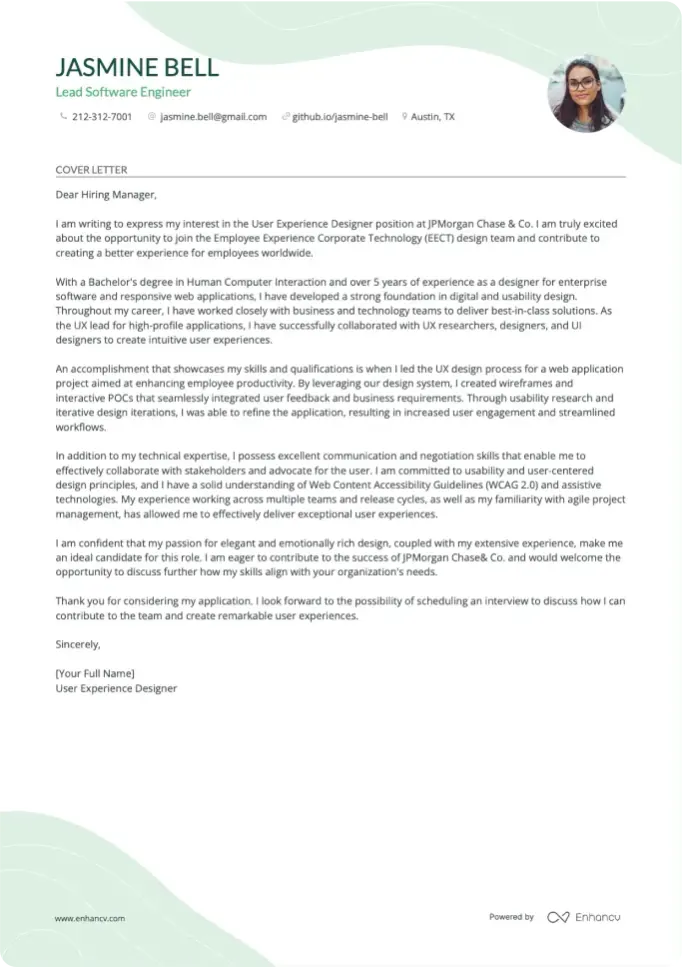Embarking on your job hunt in architectural design, you've hit a common snag: the daunting cover letter. It's not just a repeat of your resume; it's your chance to share a compelling story about your proudest professional moment. Writing this one-page letter can feel like a tightrope walk between being formal and avoiding overused clichés. We're here to guide you through this critical step, ensuring that your cover letter stands out to potential employers.
- Writing the essential architectural designer cover letter sections: balancing your professionalism and personality;
- Mixing storytelling, your unique skill set, and your greatest achievement;
- Providing relevant (and interesting) information with your architectural designer cover letter, despite your lack of professional experience;
- Finding the perfect format for your[ architectural designer cover letter, using templates from industry experts.
Leverage the power of Enhancv's AI: upload your resume and our platform will map out how your architectural designer cover letter should look, in mere moments.
If the architectural designer isn't exactly the one you're looking for we have a plethora of cover letter examples for jobs like this one:
- Architectural Designer resume guide and example
- Mechanical Designer cover letter example
- Video Production Manager cover letter example
- Character Animator cover letter example
- Mold Designer cover letter example
- Set Designer cover letter example
- UX UI Designer cover letter example
- Junior UX Designer cover letter example
- Illustrator cover letter example
- Retail Designer cover letter example
- Footwear Designer cover letter example
Architectural Designer cover letter example
Steve Macckay
San Francisco, CA
+1-(234)-555-1234
help@enhancv.com
- Highlighting relevant project experience, such as leading the design of a significant office space, which showcases the candidate's leadership and project management skills.
- Emphasizing the achievement of a Green Building Award, indicating a proven track record of integrating sustainability into design—a key component for an Architectural Designer role focused on environmentally responsible design.
- Expressing alignment with the firm's values and approach to design, helping the candidate to stand out by showing that they are a cultural fit and appreciate the firm's commitment to innovation and sustainability.
- Mentioning the result of increased client interaction thanks to the candidate's design approach, which directly ties their work to tangible business outcomes, an attractive quality in a potential hire.
The visual appeal of your architectural designer cover letter: format, font, and structure
When using our cover letter builder, make sure to include these vital sections:
- Header (with your name, contact details, the role, and date);
- Greeting (that's personalized to the recruiter);
- Introductory paragraph (to capture attention);
- Body paragraph (to tell a story of how you've obtained your job-crucial skills);
- Closing paragraph (ending with a nod to the future ahead);
- Signature (that is not a must).
Our cover letter templates are already set up for you with the best architectural designer cover letter design with single-spaced paragraphs and a one-inch margin.
As for the font of your architectural designer cover letter, use the same one as you did in your resume (where modern and simple fonts, like Rubik and Bitter, take precedence over Arial and Times New Roman).
Your architectural designer cover letter is created with the recruiters in mind - as no Applicant Tracker System looks over this part of your profile.
When sending over your architectural designer cover letter, download it in PDF. This format allows your information and design to stay intact and to keep the same visual quality.
The top sections on a architectural designer cover letter
Header: The header should include the designer's contact information, making it easy for recruiters to reach out, and it sets a professional tone for the cover letter.
Opening Greeting: A personalized greeting to the hiring manager shows that the designer has done their research on the firm and is genuinely interested in the position.
Introduction: The introduction should quickly capture the recruiter's interest by highlighting the designer's passion for architecture and summarizing their most compelling qualifications relevant to architectural design.
Body Paragraph(s): These should detail the applicant's relevant architectural experience, particular design skills, portfolio highlights, and key project successes, illustrating their suitability for the role.
Closing and Call to Action: This section should reaffirm the candidate's enthusiasm for the position, invite the recruiter to review their attached portfolio, and express their eagerness to discuss how their design expertise can benefit the firm.
Key qualities recruiters search for in a candidate’s cover letter
- Strong design portfolio showcasing a range of projects: Demonstrates the breadth and depth of design skills, creativity, and understanding of different architectural styles and types of spaces.
- Proficiency in architectural software: Shows that the candidate can effectively use essential tools like AutoCAD, Revit, SketchUp, and BIM software, which are critical for modern design and documentation processes.
- Knowledge of building codes and regulations: Ensures the candidate can design safe, accessible, and compliant structures, avoiding costly errors or redesigns.
- Experience with sustainable design practices: Highlights a commitment to creating environmentally responsible and resource-efficient buildings, which is increasingly important in the industry.
- Strong communication and collaboration skills: Essential for working effectively with clients, engineers, contractors, and other stakeholders throughout the design and construction process.
- Attention to detail and problem-solving abilities: Demonstrates the capacity to address complex design challenges and ensures that projects are executed to the highest standards and specifications.
The architectural designer cover letter salutation: how to address hiring managers
After covering the format of your architectural designer cover letter, let's look at the salutation.
Back in the day, the cordial "To whom it may concern" or "Dear Sir/Madam", might have worked out fine.
But, nowadays, your cover letter should approach hiring managers on a more personal basis.
So, what to do about your cover letter salutation?
If you've messaged the recruiters and are on a first name basis or a more formal one, use the hiring manager's name in the greeting (e.g. "Dear Sophie," "Dear Ms. Givens", or "Dear Mr. Everett,").
Always aim to make the effort to find out the name of the hiring manager, who'd be assessing your application. Search on LinkedIn, double-check the advert on the corporate website, or message the brand on social media to find out more about the role.
If you can't find the hiring manager's name (and still want to sound professional), use "Dear HR Team,", "Dear Hiring Manager,", or the likes.
List of salutations you can use
- Dear Hiring Manager,
- Dear [Company Name] Team,
- Dear [Department Name] Head,
- Dear Mr./Ms. [Last Name],
- Dear [First Name] [Last Name],
- Dear [Professional Title]
Your architectural designer cover letter introduction and the value you bring
Moving on from the "Dear Recruiter" to your professional introduction.
Use those first two sentences of your architectural designer cover letter to present the biggest asset you'd bring to the organization.
Don't go into too much detail about your achievement or the skill set, but instead - go straight for the win.
That is - what is your value as a professional?
Would you be able to build stronger, professional relationships in any type of communication? Or, potentially, integrate seamlessly into the team?
What to write in the middle or body of your architectural designer cover letter
Here's where it gets tricky.
Your architectural designer cover letter body should present you in the best light possible and, at the same time, differ from your resume.
Don't be stuck in making up new things or copy-pasting from your resume. Instead, select just one achievement from your experience.
Use it to succinctly tell a story of the job-crucial skills and knowledge this taught you.
Your architectural designer cover letter is the magic card you need to further show how any organization or team would benefit from working with you.
Closing paragraph basics: choose between a promise and a call to action
You've done all the hard work - congratulations! You've almost reached the end of your architectural designer cover letter.
But how do you ensure recruiters, who have read your application this far, remember you?
Most architectural designer professionals end their cover letter with a promise - hinting at their potential and what they plan on achieving if they're hired.
Another option would be to include a call for follow-up, where you remind recruiters that you're very interested in the opportunity (and look forward to hearing from them, soon).
Choose to close your architectural designer cover letter in the way that best fits your personality.
Addressing limited to no experience in the architectural designer cover letter
There's nothing to worry about if you lack professional experience.
Your architectural designer cover letter could bridge the gaps in your professional history by focusing on what matters most to recruiters, that's either:
- skills - focusing on transferable ones you've gained, thanks to your life experience (e.g. volunteering, certificates, etc.);
- achievements - select the most relevant and noteworthy one from your history (e.g. education, projects, etc.);
- motivation - describe how you envision your professional growth in the next up to five years, thanks to this opportunity.
Key takeaways
Within this Enhancv guide, we've provided you with plenty of advice and inspiration on writing your architectural designer cover letter:
- Always make sure your architectural designer cover letter is tailored to the role you're applying for to make a good impression on recruiters;
- In your architectural designer cover letter include a header (with your name, the role you're applying for, date, and contact details) and an introduction of up to two sentences that highlight your key accomplishment or why you'd fit the role;
- Focus your architectural designer cover letter body on one sole achievement through your career and all the valuable lessons, skills, and know-how you've learned (that are relevant to the role);
- Ensure your architectural designer cover letter closing statement isn't generic and includes either a call to action or a promise;
- If you lack professional experience, shift recruiters' focus to a relevant achievement (thanks to your academic or versatile experience) or toward your dreams and goals for professional growth.




